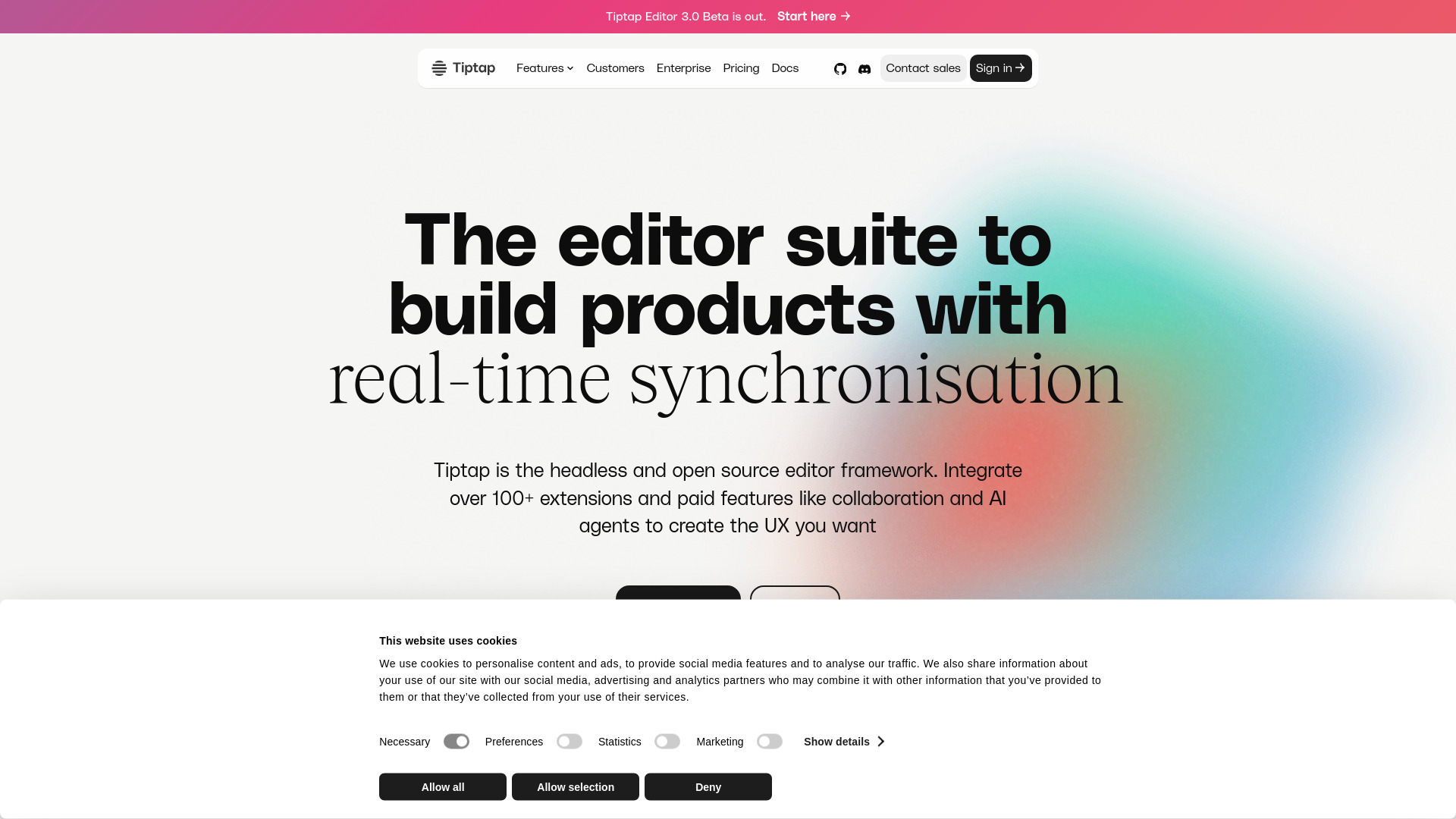- Home
- AI Copywriting
- Tiptap

Tiptap
Open Website-
Tool Introduction:Build Notion-like editors fast with 100+ extensions and AI.
-
Inclusion Date:Oct 21, 2025
-
Social Media & Email:
Tool Information
What is Tiptap AI
Tiptap AI brings AI-powered assistance and agents to the headless, open-source Tiptap editor framework. Built on ProseMirror, it lets developers compose Notion-like editing experiences with over 100 extensions and then layer in intelligent actions such as drafting, rewriting, summarizing, and structured commands. Because Tiptap is headless, teams fully control the UI/UX while benefiting from real-time collaboration, schema-safe content, and framework-agnostic APIs for React, Vue, Svelte, and more. Tiptap Editor 3.0 adds faster rendering, stronger schema tooling, and smoother multiplayer ergonomics so AI features feel native in modern web apps.
Tiptap AI Main Features
- Headless rich text editor: Build custom UI while relying on a stable ProseMirror core and type-safe APIs.
- AI assistance and agents: Draft, rewrite, summarize, and run structured prompts directly in the editor.
- 100+ extensions: Mix blocks, marks, tables, mentions, slash commands, code, attachments, and more.
- Real-time collaboration: Multiplayer editing with presence, cursors, history, and conflict resolution.
- Framework agnostic: First-class integrations for React, Vue, Svelte, and vanilla JS.
- Schema-safe content: Define nodes/marks to enforce structure, validation, and reliable serialization.
- Next-gen performance: Editor 3.0 improves rendering, input latency, and large-document handling.
- Extensible commands: Compose keyboard shortcuts, slash menus, and custom AI actions with minimal code.
- Collaboration-ready architecture: Works with a sync server to deliver low-latency, resilient co-editing.
- Theming and UX control: Brand the editor to match product design without being locked into a fixed UI.
Tiptap AI Suitable For
Tiptap AI suits product teams and developers building Notion-like editors, knowledge bases, CMS platforms, documentation tools, wikis, and collaborative writing apps. it's ideal for SaaS products that need real-time collaboration and AI-powered editing without sacrificing a custom UI/UX, and for engineering teams that prefer an open-source, headless editor over monolithic WYSIWYG solutions.
Tiptap AI Usage Steps
- Install Tiptap and choose your stack (React, Vue, Svelte, or vanilla JS).
- Define your editor schema and select core and advanced extensions you need.
- Add the Tiptap AI extension and configure your AI provider and keys.
- Implement UI elements (slash menu, toolbar, context menu) to trigger AI actions.
- Enable collaboration by connecting to a real-time sync server and persistence layer.
- Wire up commands for drafting, rewriting, summarizing, and structured prompts.
- Handle serialization (JSON/HTML/Markdown) and content validation in your app.
- Test performance, access control, and rate limits; refine UX and prompts.
- Deploy your editor and monitor usage, latency, and AI costs.
Tiptap AI Industry Use Cases
An edtech platform uses Tiptap AI to help students co-write essays with real-time feedback and AI summaries. A newsroom CMS integrates AI rewriting and headline suggestions while preserving a structured article schema. A B2B knowledge base offers Notion-like blocks with AI-generated outlines and collaborative editing. A developer documentation site uses AI to standardize tone, extract code snippets, and clean formatting at scale.
Tiptap AI Pricing Model
The core Tiptap editor is open source and free to use. Paid features typically cover collaboration, AI agents, and managed cloud services, offering commercial plans for teams that need scalability, governance, and support. Availability and terms vary by plan; evaluate the open-source path first and add paid capabilities as your product grows.
Tiptap AI Pros and Cons
Pros:
- Headless, developer-first design with full UI control.
- Over 100 extensions for rapid, Notion-like experiences.
- AI drafting, rewriting, and summarization built into editor workflows.
- Real-time collaboration with presence and history.
- Framework-agnostic and TypeScript-friendly APIs.
- Schema-safe content ensures reliable structure and portability.
- Active open-source ecosystem and frequent updates (Editor 3.0).
Cons:
- Requires engineering effort to design UI and maintain schema.
- Collaboration and AI features add infrastructure and cost considerations.
- Learning curve for ProseMirror concepts and extension authoring.
- AI behavior and latency depend on third-party model providers.
Tiptap AI Popular Questions
-
Q1: What’s the difference between Tiptap Editor and Tiptap AI?
Tiptap Editor is the headless, open-source rich text framework. Tiptap AI is an add-on that brings AI assistance and agents into the editor’s workflows.
-
Q2: Does Tiptap AI lock me into a specific UI?
No. Tiptap is headless, so you control the UI/UX and only use the APIs and extensions you need.
-
Q3: Which frameworks are supported?
Tiptap works with React, Vue, Svelte, and vanilla JavaScript, making it easy to fit into most front-end stacks.
-
Q4: Can I self-host collaboration and AI components?
Yes. You can integrate with your own real-time sync stack and choose the AI provider you prefer.
-
Q5: How does Tiptap AI handle structured content?
AI actions operate within the editor’s schema, helping preserve nodes, marks, and constraints for safe, portable content.
-
Q6: Is it suitable for large documents?
Editor 3.0 focuses on performance and ergonomics, improving input latency and rendering for big documents and collaborative sessions.



